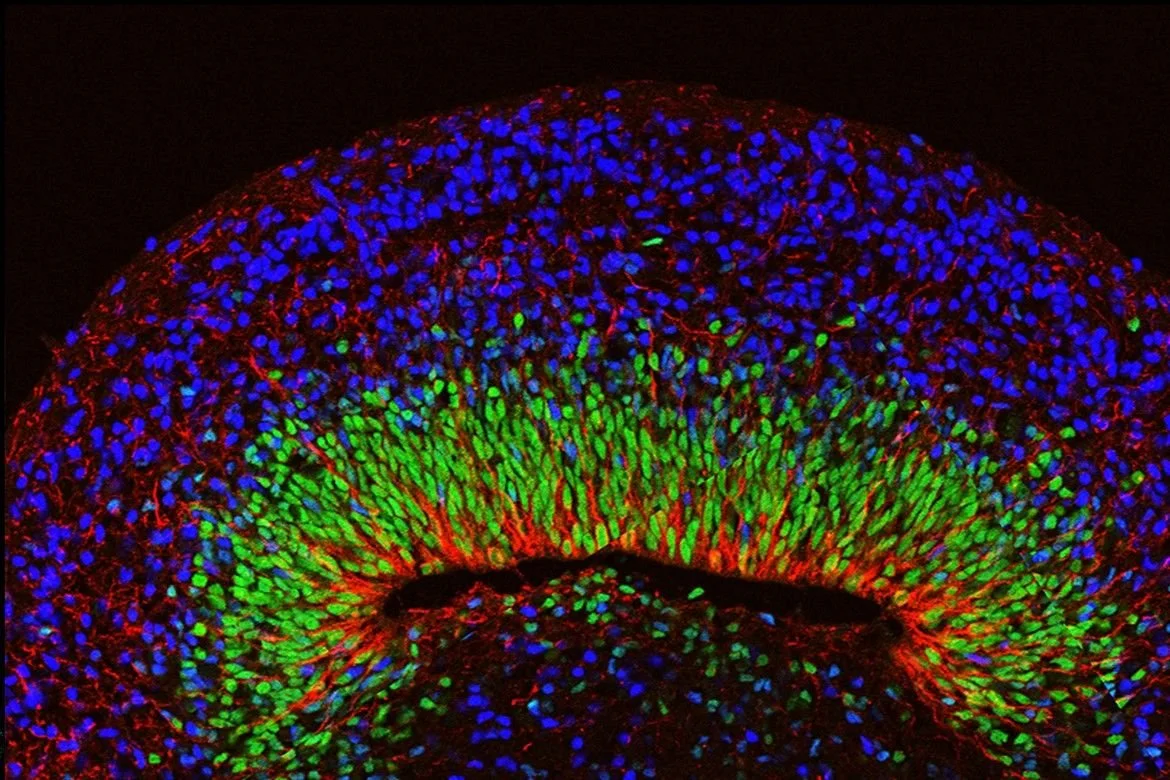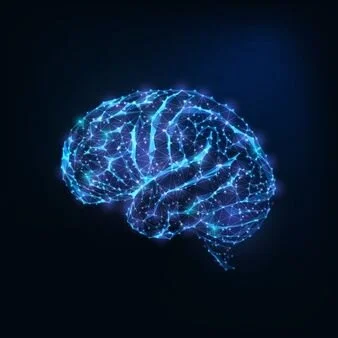Neuroscience Anthology
The Neuroscience Anthology project is part of the INI Internship program. In addition to shadowing Dr. Vokshoor in clinic and the OR, students in the internship program pick a neuroscience topic and complete an outside research paper, giving them a chance to further investigate an area of neuroscience that particularly interests them. Their reports are compiled here to create a working, growing neuroscience curriculum.
Humans possess a unique capacity to contemplate our mortality and imagine a world that continues without us. However, in contemporary Western culture, the prospect of our own or a loved one's death, however inevitable, is often perceived as a traumatic loss that instills fear and dread. We avoid discussing death with loved ones. We have few rituals or practices aimed at preparing us emotionally, during life, for our own or a loved one's death. Since our brains are hard-wired for survival, this aversion is a natural consequence of our innate drive to safeguard our existence.
Neural organoids (also termed brain organoids) are a revolutionary development in the fields of developmental biology and neuroscience. They are three-dimensional, miniaturized versions of the brain that have been simplified and created from pluripotent stem cells which can differentiate into any type of cell (Romito et al., 2016, Zhu et al., 2013). In contrast to more traditional 2D cell cultures and animal models, creating neural organoids represents a major technological shift towards more physiologically relevant approaches that consider human brain development as well as pathology in an ethical manner (Lee et al, 2022). Per se, studying neural organoids can give us the opportunity to recreate numerous features of the brain structure and functioning such as network formation among neurons and synapse establishment (Li et al., 2023). Furthermore, neural organoids can also provide useful information related to numerous neurodevelopmental disorders including epilepsy, schizophrenia, and autism spectrum disorder (Kim et al., 2023). However, there are some challenges of using neural organoids that should be considered while studying them.
One day, you find yourself on the field, track, rink, or court, listening to others applaud your ability, performance, and physical strength as an athlete. The next day, you find yourself exerting ten times as much effort in the hope of regaining just a fraction of your former strength. This unfortunate scenario is similar to what many survivors face in their daily lives following the event of a stroke. A stroke, also known as a "brain attack," is a condition in which the blood supply to the brain is blocked, resulting in a lack of oxygen.
As I prepared to begin my investigation on this neurological condition, I felt a pulsating pain start in my left temple and my vision blurred, immersing me into the reality of this disabling condition. Migraines are a neurological disorder that result in intense headaches that last from four hours to up to three days, affecting about 12% of the population (Burch et. al. 2019). One hypothesis of the cause of migraines is an increase in the levels of cortisol, a stress hormone released by the adrenal gland, increases stress levels particularly in the morning and affects the body’s metabolism, causing an increase in blood pressure and migraine attacks. There is strong evidence of sleep disruptions and disorders being associated with the frequency and severity of migraines in sufferers. Data shows that migraine-sufferers are three times more likely to have insomnia and sleep-related disorders than a non-migraine sufferer, indicating a bidirectional relationship between the two (Amiri et. al. 2022).
The standing overhead press (OHP) is largely regarded as one of the most effective strength and hypertrophy muscle-building exercises; due to the exercise having the longest kinetic chain of any lift as well as its compound nature incorporating muscle groups from the chest, shoulders, upper back, neck, and core. Standing OHP is trained by athletes, recreational lifters, and even in the military. While the standing overhead press may be an excellent exercise there is reason to believe there are potential downsides to the participant's long-term disc health.
Studies have shown that meditation has numerous health benefits, including consistent correlations with decreases in pain and anxiety, which has more recently been investigated with regard to patients undergoing surgery. Preoperative anxiety can have deleterious effects on patient experience and surgical outcomes including impaired wound healing and increases in postoperative complications. To learn more about the recent research into the applications of mediation for enhancement of patient operative experience, you can view our anthology post on the topic. Do you have your own meditation or mindfulness practices?
Moyamoya disease is a rare cerebrovascular condition characterized by progressive stenosis of the internal carotid artery. The stenosis and resulting hypoplasia of the internal carotid artery lead to the dilation of proximal blood vessels as a consequence of the body's attempt to compensate for the reduced blood flow. The enlargement of the minor vasculature can be seen on an angiogram and is often compared toもやもや (moyamoya), which is Japanese for a "puff of smoke"
Horner's syndrome is characterized as a rare condition best identified by three main symptoms: miosis (pupil constriction), ptosis (upper eyelid sagging), and anhidrosis (inability to secrete sweat). It may also present with symptoms such as the inability to completely shut or open the eyes, flushing of one half of the face, frequent headaches, and sharp pains. Horner’s occurs as a result of damage of the sympathetic nerves that supply blood to the face. Root causes of Horner's syndrome vary greatly, however most stem from damage to the sympathetic nerves via a tumor, stroke, injury, etc.
Psilocybin, the principal psychedelic ingredient of hallucinogenic mushrooms, has received significant attention as a scientific research tool due to its potential therapeutic effects. Psychedelic research was prolific during the 1960s but ceased with the Controlled Substances Act of 1970. This act placed serotonergic psychedelics, such as psilocybin and LSD, into schedule I of the US Drug Enforcement Administration’s list of controlled substances. However, human psychedelic research resurfaced in the 1990s and has been growing ever since. This article will examine psilocybin with its properties and potential for treating illnesses, such as chronic pain.
The blood-brain barrier (BBB) is crucial to maintaining central nervous system (CNS) homeostasis. Through a combination of physical and molecular barrier properties, and a number of highly specific transporters that exercise fine control over the movement of nutrients from blood vessels into the CNS or waste products back out into the bloodstream, the blood-brain barrier keeps tight regulation of everything going in and out of the CNS (Daneman & Prat, 2015). While this is useful for protecting the CNS from toxins and pathogens, this presents a unique challenge for non-invasive delivery of therapeutic agents in the treatment of brain cancers.
The coronavirus disease 2019 (COVID-19) was first reported on December 2019 in Wuhan, China and has become a global pandemic due its worldwide spread. COVID-19 is mainly known for causing respiratory symptoms, however in severe cases, it may also cause neurological harm. Neurological manifestations of COVID-19 affect both the central nervous system (CNS) and the peripheral nervous system (PNS). One of the symptoms of the coronavirus in the CNS include epilepsy (Azhideh 2020).
As we enter 2021, the novel coronavirus (CoV) disease 2019 (COVID-19) remains a threat to global health and economies. Since the beginning of the pandemic, one of the most striking changes to daily life has been maintaining social distancing and limiting in-person social interactions. Social relationships have long been understood to act as a protective factor against a wide range of health conditions. In the coming years, it may be particularly important that mental health professionals understand how social isolation impacts brain functioning and psychological well-being.
To achieve as much mobility as possible without compromising the body’s structural integrity, the cervical spine relies on a careful balance between flexibility and stability. In order to achieve this balance, an incredible amount of spinal structures must work together as a team to ensure the body is functional and protected. A stable spine is necessary to not only protect the spine, but also preserve nervous system functions, such as walking (Izzo et al., 2013). Furthermore, spinal instability may be detrimental to a sufferer’s quality of life. Back issues risen from spinal instability may cause functional difficulties in daily life in addition to possible severe chronic pain.
Minimally invasive surgical techniques for spinal surgery are on the rise. The endoscope, a tool used to observe and operate internally has been increasingly featured in many minimally invasive techniques, and the market for endoscopy is projected to grow to a 44 billion threshold by 2025. Other minimally invasive techniques, like microdiscectomies and other microscopic surgeries, are becoming prominent as surgeons wish to do less damage to their patients’ tissue.
Epilepsy is defined as a disorder of the brain characterized by an enduring predisposition to generate epileptic seizures. In this paper, a seizure refers to a sudden burst of electrical activity within the brain impairing an individual for up to 3 minutes or more. A diagnosis of epilepsy is dependent upon the reoccurrence of severe seizures over a 10-year time period. According to the Centers for Disease Control and Prevention, the prevalence of active epilepsy in the United States was 1.2% in 2015. Research has revealed that up to 60% of people living with epilepsy (PWE) had associated depression, and a seizure frequency of >1 per month produced a 2.5 times increased risk of depression.
Lhermitte’s Sign, also known as the “barber chair” phenomenon, refers to an electric sensation that travels down the spine from the neck to the limbs. First described in 1917 by patients with multiple sclerosis (MS), Lhermitte’s Sign did not gain formal recognition until French neurologist Jean Lhermitte published a detailed report on the phenomenon a few years later (Lim et al., 2010).
Three of the most life-altering words to hear from a physician are inoperable, malignant, and tumor. One of the most common, but insidious, malignant brain tumor diagnoses is Glioblastoma Multiforme (GBM) (American Cancer Society, 2019). With an average survival rate of less than 15 months from diagnosis, GBM is particularly intractable to treatment and quickly spreads to surrounding neuroepithelial tissue, impeding blood supply, which renders chemotherapy even less effective.
Adderall. It’s a drug that has become so familiar since it hit the market in 1977 that most people recognize the name immediately. But why would our culture foster such knowledge of a prescription drug used to treat Attention-Deficit / Hyperactivity Disorder (ADHD)?
When we look up to see the sky crossed by a white trace, we can follow the white vine of water-vapor to its seeding source, the burning engine of a jet. What if we could similarly trace the thread-like connections of the brain? Diffusion tensor imaging (DTI) is a technique for imaging the brain that allows us to describe the structures of the brain’s connections by contouring the diffusion, or directional movement, of water.
Picture yourself building a skyscraper in downtown Los Angeles with nothing but titanium-reinforced I-beams and concrete that is so brittle, even the slightest touch could make the foundation shatter. This is analogous to what spine surgeons are facing when patients with osteoporosis are in need of spinal fusion and/or fixation from trauma, degeneration, or spinal stenosis.
Although the idea of and experiences associated with pain leave people with negative perceptions of it, feeling pain is essential for human survival. The experience of pain within the human body serves as an “alarm system,” and allows humans to recognize, react to, and in the future, avoid stimuli that create pain in the first place. Nociception is the process through which the sensory nervous system senses and perceives painful stimuli, which then allows for the triggering of appropriate reactions.
Major Depressive Disorder (MDD) is a mental disorder of complex etiology. Synthesized with the amino acid tryptophan, the neurotransmitter serotonin is involved in mood regulation; specifically, decreased levels have been shown to contribute to an increase in symptoms of depression. In an attempt to challenge the status quo, current interventions for MDD must be explored, identifying the specific effects neurotransmitters have on depression, and determining how tryptophan could potentially be used to treat depression.
From Tibetan monks to your everyday layman, anyone can reap the benefits of meditation. Various forms of meditation can be a useful tool for both pre- and post-operative therapy and can be used as a form of buffing the brain through cognitive “housekeeping,” or as a preventative measure that can be accessed and practiced by anyone.
…Combining these concepts gives a unique way to image the complex activity in the brain: magnetoencephalography (MEG), a neuroimaging technique that detects the magnetic fields generated by neurons themselves. MEG is a noninvasive and precise technique that eliminates the need for induced magnetic fields, contrast dyes, or harmful radiation.
“...Those obdurate and sometimes tormenting ghosts of arms and legs lost years or decades before but not forgotten by the brain.”-V.S. Ramachandran
Phantom sensations are sensory perceptions of a missing limb. Phantom limb pain is a neuropathic pain in the amputated limb and mostly reported in limb amputees.
One of the most common and life-threatening birth defects are known as neural tube defects (NTDs). These defects are categorized by an opening in the spinal cord or brain during development. Additionally, a less common spinal cord disorder also occurs in adults called adult tethered cord syndrome. This may go undiagnosed until adulthood when pain, sensory, and motor problems occur in a patient’s back.
Pain and its knowledge of transduction, transmission, perception and modulation are essential in pain management. Understanding how pain signals reach the brain and understanding the many different techniques that may result in pain relief is imperative.
The practice of intermittent fasting (IF), or cycling between periods of ingesting and abstaining from food, has long been revered in religious and spiritual communities as a demonstration of self-restraint, discipline, empathy, and as a method of mental and bodily detoxification.
When considering the problems that arise after traumatic spinal cord injuries (SCI), the most commonly addressed issues are numbness and tingling in the extremities, focal weakness, or paralysis, but one of the most persistent and difficult to treat co-morbidities is long term clinical depression.
Post-Traumatic Stress Disorder (PTSD) is a fear-related psychological disorder that has remained to be a therapeutic challenge for years. PTSD can result from witnessing or observing traumatic events that are possibly life-threatening, severely disturbing or that pose threatening bodily injuries.
“Any man who reads too much and uses his own brain too little falls into lazy habits of thinking”- Albert Einstein [6]. Einstein perfectly sums up the importance of the brain for cognitive functioning throughout our daily lives. Effective cognition results from an efficient functioning of the various molecular pathways in our brain. Let us focus on one molecular aspect of the brain- Microglia. Microglia are types of glial cells, which act as macrophages and are present throughout the Central Nervous System (CNS). These non-neuronal cells are responsible for the protection and support of neural activities. They are widely distributed throughout the brain and spinal cord and make up about 5-20% of glial cells within the CNS [1]. The two noteworthy features of the microglia are CNS maintenance and immune defense. An appropriate balance of microglial concentration is required to promote homeostasis of the CNS [1].
Dimethyl Sulfoxide (DMSO) was discovered in the 1950’s to be used as a useful treatment for a myriad of conditions. First discovered in its industrial applications, this essay will examine its properties and promise for treating various ailments including intracranial hypertension. Being a small molecule, slightly larger than water, DMSO penetrates into the skin almost immediately, making it useful as an agent to improve the transport of drugs deeper into targeted tissues.
Football is the great American pastime. Large numbers of athletes at the youth, high school, and college levels participate in organized football. At the professional level, the sport generates a huge amount of media attention, interest, and revenue. In recent years, however, warnings about the brain injury risks inherent in football have come from retired players, coaches, and medical professionals, along with increased public awareness about the danger of repeated head trauma.
Every 15 seconds, someone suffers from a traumatic brain injury, due to car accidents, contact sports, or simply getting hit in the head. Although most people survive, concussions should not be taken lightly, because they impair neurological function. The effects of concussions are cumulative, thus, repeated head injuries can result in chronic traumatic encephalopathy (CTE).
Mirror neurons have been referred to as the "most hyped concept in Neuroscience". Mirror neurons were first discovered in the 1990s by chance when a team of Italian scientists was studying the mechanisms behind certain actions and recording neuronal control of motor activity in macaque monkeys. These scientists saw that the same cells were activated when a monkey observed an action as when the monkey performed the same action itself. This fascinating discovery has allowed us to expand on our ambitions of a greater understanding and insight to certain behaviors.
The human brain is a complex neural network with countless abilities. An important part of the human brain is the ability to formulate memories. Additionally, sleep is an important state that is vital for adequate brain performance, such as memory formations. Individuals who generally receive low hours of sleep perform poorly the following day on various tasks, especially memory tests. Thomas et al. states, “Problematic sleep can be detrimental to the development of important cognitive functions, such as working memory, and may have the potential for negative consequences” (2014). In other words, sleep is required nightly for adequate daytime functioning and maintaining proper neural functioning. Receiving low hours of sleep and experiencing sleep problems can often correlate with poor mental performances, such as forgetfulness, absentmindedness, and/or misattribution.
Emotions: we all have them. In fact, you are experiencing this phenomenon at this very moment. But, what is an emotion, really? Is it a tangible anatomical function that scientists can map on a brain, or is it an abstract idea that humans have developed as a scapegoat for irrational behavior? As it turns out, emotions are a mixture of the abstract and the concrete.
Parkinson’s Disease (PD), one of the most prominent neurodegenerative disorders, is a chronic neurological disorder where progressive degeneration of the nervous system manifests primarily as loss of control of the body’s motor system.
“Biopsychosocial” is a term that has been used in the medical field in association with chronic pain presentations (Jacob, 2003). Chronic pain patients are often seen by various doctors and when treatments are ineffective, the patient is categorized as having biopsychosocial influences on pain. “Bio” refers to the physical aspects of pain such as disc herniation, joint dysfunction, and muscular disturbances. “Psycho” refers to the psychological factors of the patient. Is the patient depressed or do they have any catastrophizing tendencies? “Social” may be in relation to work stability, familial relationships, and social interactions. All three aspects combined demonstrate a wide variety of information for the patient’s brain to process their pain. Through research and advancing technology, the word biopsychosocial is losing its notoriety. Today research is showing a stronger relationship of biopsychosocial aspects having neurological changes with chronic pain.
Many in medicine believe the spine to be the center of bodily wellness, and health. Naturally, as the center of all mechanics of the body, it is subject to intense physical stress. Major improvements have been made in stabilizing the spine and resolving herniated or degenerative intervertebral disks. Before, such medical issues would require fusion, but would entail a total loss of function of the joint by essentially making one bone out of what used to be two (Spinehealth). Now, doctors can preserve the natural flexibility of the spine with new prostheses such as the prodisk variety. These designs make an excellent mimicry of the natural motion of vertebral joints, as do other prostheses (Synthes Inc.), however they fall short in replicating one crucial role that intervertebral disks play. In addition to acting as a ligament for a vertebral joint, discs act as necessary shock absorbers, protecting the network of bone and nerves from major traumas and force.
Neurofeedback (NFB) treatment seems like part of a plot derived from a science fiction film. Simply by playing a video game, patients are able to self-regulate and improve their brain function. Using either EEG or fMRI NFB, subjects are monitored and presented with their brain activity in the form of a game, so that they are able to alter their brain activity towards more desired levels. With the non-invasive approach of NFB, many patients have been able to treat their mental disorders with cognitive therapy and brain enhancement (Zotev, Phillips, Yuan, Misaki, & Bodurka, 2014). NFB is a very real concept, and is making waves in the world of neuroscience.
Environmental enrichment (EE) is the effect of enhanced sensory, motor, and cognitive stimulation on the neural circuitry of the brain. The evidence for this has been established by studies with enriched housing conditions for rodents and its effects on their brains in comparison to those in normal housing conditions. The idea behind the experimental paradigm is that rodents exposed to an enriched environment have enhanced stimulation of their sensory, motor, and cognitive systems and thus have a more refined neural circuitry. The result is a modified progression of cognitive decline associated with aging and neurodegenerative disorders like Alzheimer’s disease (AD). Enrichment studies have been conducted on mouse models of AD to determine its precise cellular and molecular effects on disease pathology. A significant positive effect would mean a potential for new strategies in therapeutic research.
Complex Regional Pain Syndrome (CRPS) is a debilitating condition characterized by non-dermatomal patterns of pain, sensory abnormalities, autonomic dysfunction, and motor changes. It can be differentiated into two types based on the absence (CRPS I) or presence (CRPS II) of detectable nerve trauma, yet the distinction is not often made in scientific literature due to limited clinical differences.
Referred to as the “Mother Board” by many physicians and scientists, the brain is responsible for much of how our body functions day-to-day. In particular, the autonomic nervous system regulates involuntary body functions such as heart rate, blood pressure, and body temperature. The cerebellum also plays a key role in the body’s coordination and ability to balance. Being that these systems play important roles in the functionality of the body from day-to-day, a flaw in these centers causes major disruptions. Neurodegenerative diseases are categorized by the effects that they have on our bodies. One disease of interest is Multiple System Atrophy (MSA), a fatal disease causing loss in motor function, abnormal heart rate, increased blood pressure, and body tremors.
Perplexing to physicians is the finding that patients with the same type and degree of injury may complain of vastly different levels of pain exacerbation, including pain severity, debilitation, life effects, and relative control. Evidence suggests that this phenomenon is due to psychosocial factors that are compounded by patient’s unrelenting symptoms, an insufficient availability of impactful treatments, and the extensive effects of such pain on physical function (Moriarty, McGuire, & Finn, 2011). These factors affect cognition of pain, thereby impacting pain exacerbation and initiating neurobiochemical changes throughout the Central Nervous System (CNS) that further compound and reinforce pain conditions.
Meditation originated from ancient eastern practices and has been part of its culture for 2,500 years (Taylor, Daneault, Grant, Scavone, Breton, Roffe-Vidal, ... & Beauregard, 2012; Otani, 2003). Meditation was used to facilitate enlightenment as a way of overcoming hardship, pain, stress, and sorrow (Otani, 2003). It is a mental process that relaxes the individual and induces multiple physiologic responses (Lazar, Bush, Gollub, Fricchione, Khalsa, & Benson, 2000). Meditation alters both cognitive and sensory dimensions of an individual’s subjective experience (Zeidan, Martucci, Kraft, Gordon, McHaffie, & Coghill, 2011).
The practice of meditation extends beyond relaxation and the typical yoga class. There are different types of meditation such as Transcendental Meditation and Mindfulness Meditation that have received the most scientific attention. Meditation can be practiced on its own or as a part of yoga, t'ai chi and other practices. (Horowitz, 2010, p. 223). Other forms of meditation include body scanning, guided meditation, and deep breathing. Practicing meditation has the ability to benefit individuals with Traumatic Brain Injuries (TBI) through the association of neuroplasticity.
Each year, there are approximately 12,000 spinal cord injuries (SCI) in the United States. These devastating injuries occur occur when severe trauma to the spine fractures or dislocates vertebrae, causing the spinal cord to bruise or tear. Spinal cord injuries exhibit a broad range of severity ranging from incomplete to complete. In incomplete SCI, sensation and movement is partially lost below the site of injury. In complete SCI, all sensory and motor functions below the site of injury are completely and permanently lost, resulting in paralysis.
You wake up one morning, and slowly you prop yourself up in bed as your joints, having braved the unmerciful test of time, ache and creak. Suddenly, an elderly woman walks in with a tray of your favorite breakfast foods and radiantly greets you. Naturally, you inquire, "Excuse me, I appreciate the food but may I ask who you are?" Her smile disappears. The creases in her face deepen as she replies, "Honey, I'm your wife."
Parkinson's disease is a movement disorder that is characterized by the progressive degeneration of dopaminergic neurons in the brain, particularly in a region known as the substantia nigra. This region is part of the basal ganglia, which is responsible for the initiation, coordination, and overall control of movement. As the disease progresses, the lack of dopamine in the brain leads to loss of control over voluntary movements, causing symptoms such as tremor, bradykinesia, and rigidity in muscles. Non-motor symptoms of Parkinson's include depression and loss of smell.













































